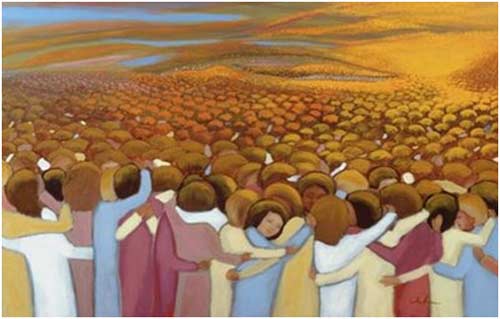
Let us pray (in silence) [as we rejoice and keep festival in honour of all the saints]
pause
Almighty God,
your saints are one with you
in the mystical body of Christ:
give us grace to follow them
in all virtue and holiness
until we come to those inexpressible joys
which you have prepared for those
who truly love you;
through Jesus Christ our Lord,
who is alive with you in the unity of the Holy Spirit,
one God now and for ever.
Amen.
NZPB p.670
This collect wonderfully expresses the doctrine of the whole church as the “mystical body of Christ” (Rom 12:5, 1 Cor 12:27; Col 1:24; Eph 1:23, 4:12, 5:30-32). The collect concludes by alluding to 1 Cor 2:9.
Cranmer composed this collect for the 1549 Prayer Book:
ALMIGHTIE God, whiche haste knitte together thy electe in one Communion and felowship, in the misticall body of thy sonne Christe our Lord; graunt us grace so to folow thy holy Saynctes in all virtues, and godly livyng, that we maye come to those inspeakeable joyes, whiche thou hast prepared for all them that unfaynedly love thee; through Jesus Christe.
1662 substituted “blessed” for “holy,” and “in all virtuous and godly living” replaced “in all virtues, and godly livyng”. “Unspeakable” has clearly changed its meaning, and here becomes “inexpressible”.
The English sixteenth century reformers followed German reformers producing a calendar with only New Testament saints and this festival. There was no distinction between “All Saints” and “All Souls”.
From the third century we have evidence of celebrations of All Martyrs. The East continues a fourth century tradition of “Sunday of All Saints” being celebrated on the Sunday after Pentecost. East Syrians celebrate this on the Friday of Easter Week. In the early seventh century the Pantheon, which had been closed for over a century, was dedicated to St Mary and All Martyrs. By the eighth century November 1st was growing in popularity for the celebration of All Saints, possibly originating in Ireland. By the ninth century the date had reached Rome and then the Holy Roman Empire.
While for NZ Roman Catholics the feast has been demoted from being a holy day of obligation, for NZ Anglicans it has recently been upgraded. In NZPB it was an “Other Feast and Holy Day” B section (page 8). Now it is one of the twelve Principal Feasts (I’d love someone to explain to me the difference between a feast and a holy day – Why, for example, is Maundy Thursday a principal holy day, and Ascension Thursday a principal feast?)
All Saints’ Day is celebrated on either 1 November or the Sunday falling between 30 October and 5 November; if the latter there may be a secondary celebration on 1 November.
Whilst there might be a change of gear at this time in the celebrating of Ordinary Time towards a more eschatological focus, including in the readings (as well as a change to Spring or Autumn climate), I am yet to be convinced by the creation of a completely new Season “Kingdomtide” (inclusively “Reigntide”?) complete with its own colour (Oh which one have we used least? – let’s make it Red).
All Saints’ Sunday is clearly a good date to celebrate baptism – incorporating new members into the mystical body of Christ.
All Saints’ is often given as “All Hallows”. Following Jewish precedent the feast begins with evening prayer the evening before – All Hallows’ Eve. All Hallows’ E’en is better known as “Halloween”. The collect for Halloween is the one above.
As this is the collect for the feast day not for the week that follows All Saints’ Sunday, during the week the collect is that of the Sunday propers that All Saints’ Sunday has replaced.
